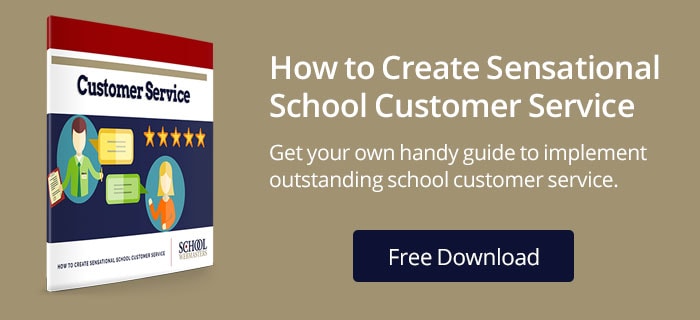We can all agree that customer service is a part of K–12 education these days. In fact, there isn’t any sector in which customer service isn’t an expectation if the company or organization expects to remain relevant (or in business).
Admittedly, the type of customer service we must deliver in education is different from retail or other service organizations, but essential nonetheless. It is actually a bit more complex because our relationships are more so. Our services go beyond briefly serving our customers. Our interactions affect students’ lives, helping them to become responsible, contributing members of society (while partnering, encouraging, and engaging their parents at the same time).
Today, unlike in the not-too-distant past, public schools were the only game in town, so parents and students were forced to accept the status quo. When bureaucracy and rudeness reared its ugly head, a bit of whining and complaining was the only recourse. Not so today—and maybe that is a good thing.
The goal is to create customer-focused institutions that rival that of any business. We mustn’t let inefficiency, mistrust, and bureaucracy get in the way of our real jobs—educating future generations.
So, what follows are some tips for improving the level of customer service we provide to our customers (who include students, their parents, our communities, and even our co-workers).
- Think convenience. We all expect self-serve options today. We also expect to be able to get what we need without ever leaving our digital device. That means our schools are held to that same standard. If we expect people to complete student forms or forms for enrollment or or staff member requirements, those forms must be available online. We should be sure our online information is available at their fingertips and easy to find (or at least in a logical place so their searching isn’t in vain). Being considerate of our customers’ time and effort is just one example of expected customer service in our digital age.

- Secret shoppers. Begin by testing the customer experience for yourself. Don’t assume that you already know what that is like, but look at your touchpoints from a completely objective viewpoint. Have someone sit down at a computer and ask them to find specific information from your website. Is it intuitive, logical, and current? Or is it frustrating or impossible? Now have your “secret shopper” use the phone tree and see how simple it is to get through to leave a message. See if anyone gets back to them and how friendly and helpful the conversation is when they do speak to someone.
- Roll out the welcome mat. Okay, this isn’t just the welcome mat or even just the front office, but it can begin in the parking lot. Is it hard to find? Is there disability access? Are the hours of availability posted both online and on the building and are both correct? Are your grounds clean and neat and the signage welcoming or cluttered and forbidding? What about your office entry? Is it institutional or does it reflect your school spirit with student art, a video slideshow, and a welcoming front office with staff that makes eye contact and welcomes visitors with a sincere smile? Are the words and tone used with customers and one another what it should be?
- Be better than “Good Enough.” I’m sure you’ve heard the phrase “it’s good enough for government work,” but today’s standards for the education sector is no different from what feels good enough for any industry. Like it or not, the bar has been raised. Strive for being a Nordstrom and avoid being the DMV. That means being timely and considerate. Doing it right the first time is far better than a belated apology after missing the mark.
- Eliminate waiting. Take a look at the ways you make your customers wait. Can they get through on the phone when they call, or are they stuck forever in phone tree hell? Encourage your office staff to grab that phone by the third ring and say hello with a smile to see what a difference it makes on those initial customer service contacts. When someone (student or parent) comes to the front office, how quickly does someone in the office make eye contact and acknowledge them? How quickly do you expect staff to return parent calls? Is there a standard you strive for? If not, make sure there is.
- Own the handoff. Set a standard that when a handoff is needed, whoever is the initial contact recognizes that they own it. This can happen when someone promises something to a customer like “We’ll have his teacher call you,” or “We’ll let the principal know,” or maybe the initial contact doesn’t have the answer and needs to direct the customer to someone else. Whether or not you have the answer or expertise, assuring that the ball didn’t get dropped on the handoff builds trust and provides the kind of customer service you would want to receive if it were you.

- Admit mistakes. There will be mistakes. They are a fact of life, and your school and staff are not exempt. Sometimes staff will need to apologize for something that wasn’t within their control or was something they had nothing to do with. But an apology, especially one that shows empathy for the customer’s situation, will go a long way toward building bridges of trust (and forgiveness). Having staff comfortable with saying, “I’m so sorry this has happened. Let’s see what we can do to fix this (make it right, solve this, etc.)” is training that will translate into a lot of goodwill.
- Get to yes. The goal, in a customer-focused driven school culture, is to find ways to get to yes with your customers. Other than the obvious privacy, safety, and security issues, more times than not, there is a way to get there. Far too often, especially in organizations, the default answer is, “if you call back tomorrow…” or “that isn’t the way it is done here,” or “that isn’t my department.” Your default can easily switch to yes with a bit of encouraged ownership for problem-solving. The “yes” answers to these three examples should be obvious and with a bit of role-modeling, the new norm.
- Model, train, hire. Many institutions tend to inadvertently grow, or allow, what the author of High-Tech, High-Touch Customer Service, Micah Solomon, calls “situational tyrants.” These are the folks who have the power to say “no” in their circle of influence and who use that power frequently. Keep these people from undermining your customer service culture efforts by getting them on board with a customer mindset as quickly as possible. This will mean looking for any evidence of their showing that spirit of getting to yes and rewarding that behavior to encourage more of it. Have them help you root out processes that are no longer necessary or are just there “because it has always been done that way.” These folks are often good at implementing improvements when empowered.
- Share information that your customer wants. Far too many school websites are filled with content that is about the school and its needs instead of content about what the parents need. Consider regular articles that address topics or contain stories that are about your customers’ needs or wants. It might be a monthly article on a topic that helps parents be parents on a myriad of topics like “quick, nutritious lunches your kids’ friends will envy,” “tips to get your student to share their day’s happenings,” or “preparing your preschooler for a great kindergarten experience.”
- Surprise them with good news. This tip mostly applies to teachers, but counselors and coaches could do this as well. Surprise parents with a note, text, or phone call about something their child is doing well—no reason other than you just wanted to share something you noticed that they might enjoy hearing. Ideally, every first contact with parents by teachers should be a positive one, and this is a great customer service standard to make that a reality.
- Share examples. Gather and share (regularly) examples of when staff has received (or witnessed) excellent customer service from their co-workers. Create an easy-to-submit process for sharing these examples, and find ways to highlight them at staff meetings, in conversations with staff, on the staff intranet, or in written exchanges. You could begin by asking every staff member to share one great experience of outstanding customer service so you have a pool of examples to draw upon.
- Create a contest. As in the above tip, gather great customer service examples from your customers as well. You can turn it into a contest and begin with students. It could be examples they see from staff members or their peers. Share the results on social media. This shows that you value customer service as well as helps others notice such examples (and emulate them).

- Ask for feedback. While this might sound a bit scary, you can’t fix what you are unaware of, so create ways to get feedback from your customers. This is fairly easy to accomplish with surveys (online, hard copies, through the PTA/PTO, or as part of events like teacher conferences or meet-the-teacher night). Put a feedback form on your website and invite students, staff, and community to contribute. Find out what areas are in need of improvement as well as where you are doing a great job. Share the good news with staff, and work on strengthening the areas of weakness.
- Share feedback reactions. Once you’ve received feedback and made improvements, let folks know what you’ve done to incorporate that feedback into your culture or processes. This will not only let people know they are heard but will show evidence that you are reactive and transparent. You’ll build trust and earn future goodwill.
- Puttin’ on the Ritz. At the Ritz Carlton, known for their amazing customer service, they have three rules that are easy enough to implement at your school. 1) Start with a warm and sincere greeting, 2) Use their name. Don’t be afraid to ask it if you don’t know, and then use it in the conversation, 3) Leave them with a warm goodbye. These three simple standards are a good place to start if you have nothing in place yet.
- Small acts have a big impact. In K–12 education, everyone involved shares a common purpose (why we are here). But sometimes our individual role in that common purpose can get lost in our day-to-day tasks. When staff understand how their particular role fits into this common purpose, going out of their way to meet and exceed customer expectations no longer feels like an imposition, but an honor. Recognize, model, and encourage small acts of service so everyone will recognize their big impact on your school’s success. (Being friendly, smiling a greeting, starting conversations, asking questions, listening actively, providing assistance, and other simple acts can become the norm.) Let the staff know it is okay to be off-task sometimes when they are serving the common purpose.
- First impressions. Take a look at each touchpoint of first impressions, and do some quick clean-up there. How does your school look on the first visit? Is it clean? Inviting? Is the signage clearly marked and friendly? How does your website serve first-time visitors? Do they know what your school does well? Is it inviting and intuitive? How quickly are phone calls answered and guidance provided? Negative first impressions are difficult to reverse, so make them count.
- Accepted as a valuable asset. Every member of your staff and even the on-site volunteers should know that school customer service is a valued asset (even an economic asset) rather than an expense or inconvenience. The school leaders must continually demonstrate that this return on investment (of their staff’s time) justifies those short-term costs and will influence attitudes and learning for generations. Each touchpoint matters and is valued.

- Recognize your stars. Go out of your way to notice and acknowledge the individuals (staff or student) who exemplify good customer service. Share those stories with others to show that you value that behavior. Reward those behaviors, and you’ll begin to see more of the same.
Just get started. Effective school customer service always begins with a customer-focused mindset. School staff must see their individual roles as vital to the school’s success as well as see the benefits it can provide to them personally. Customer service attitudes are the outward expression of your school’s culture. Its impact on student learning, and their willingness to learn, is obvious. The support your school enjoys from the community as a whole is also, in large part, affected by how you value customer service measures.
So, is it worth the investment of time and training? You bet it is!
Start anywhere, but start today. Need some help turning your website into a customer service resource? Call us at 888.750.4556 or request a quote!
Posted by Bonnie Leedy, CEO, School Webmasters, LLC.









